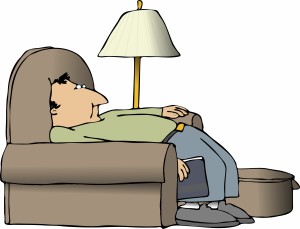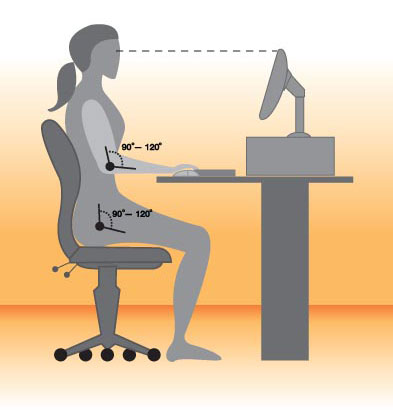Today 86% of employed Americans have jobs that require them to sit for the entire workday. Between sitting to eat, commuting, sitting at work, returning home and watching television we sit an average of 9.3 hours per day. Humans were designed to move, not to be sedentary, and the modern world makes it difficult to combat the deskbound trend. All this sitting is detrimental to your health, not only causing orthopedic issues through postural stress but also physiological declines that can shorten your lifespan. The latest research has resulted in the slogan “sitting is the new smoking”; here are the facts:
- People with sitting jobs have twice the rate of cardiovascular disease as people with standing jobs
- Sitting 6 hours per day makes you up to 40% likelier to die within 15 years than someone
- who sits less than 3 hours or less. This remains true even if you exercise
- Obese people sit for 2.5 more hours per day than weight appropriate people, currently 1 in 3 Americans are obese
- Between 1980 and 2000 exercise rates have remained the same while sitting time has increased by 8% and obesity has doubled
- Sitting expends almost no energy compared to other tasks:
- Calorie burning drops to 1 calorie per minute
- Enzymes that help break down fat drop 90%
- Electrical activity in your legs shuts down and circulation of blood decreases
- After 24 hours good cholesterol drops 20% and insulin effectiveness drops 24%
 Yes, your chair is killing you!
Yes, your chair is killing you!For the majority of us, sitting for over 8 hours a day at our job is inevitable. The battle against this modern day health menace is not hopeless however. There are three lines of defensive strategy that can reduce your risk of a serious problem becoming lethal.
1st Line of Defense:
Interrupt sitting whenever you can, stretch, walk or perform other calisthenics. Walking burns 3-5 times more calories than sitting does, improves circulation and overall physiology and can improve cognition. Yes, walking improves your ability to think!
Take 5 Every 30: While at work, every 30 minutes take 5 to get up and move. This does not imply you need to stop working; you simply need to get out of the sitting position.
Need to deliver a message to someone in your office? Walk over and inform them verbally, it’s more personable than email, will improve intra-office customer service and it’s the healthy choice for you. If you are thinking this is just an inefficient, time consuming practice then there are many alternatives and no other excuses. If funds are available purchase a treadmill desk(yes, that is a thing!) Cannot leave your desk or cubicle? Then every 30 minutes (set a timer)get up from your desk and use some of these ideas:
- Perform 20 squats
- Perform 20 calf/heel raises
- Perform 10 lunges
- Squeeze your shoulder blades together 20 times
- Stand at your workstation for the next 15 minutes
- Stand on one leg for one minute, then switch legs
Click Workstation Exercises Programfor instructions, print the PDF file and pin it above yourdesk to remind you.
2nd Line of Defense:
Reduce sitting at home or away from work. This can be difficult because you essentially have to jump start your body after it has been lulled into a state of low function during your workday.The biggest contributor to compounding your sitting-related health risk is watching television.Those who sit and watch television for 3 hours or more are 64% more likely to die from heart disease.
So avoid the TV and find another activity that you enjoy. The key to finding another activity is the root word active. Exercise after working is a key defense against the depression of all your body systems that have occurred while sitting. Make the lifestyle choice of routinely exercising every day, whether it is walking outside, at gym or being involved with an activity that you enjoy.Make a plan to participate in this activity with coworker or family member. Revealing your goal to others as well as having someone for whom you are accountable will improve your success.This will not only help combat your the physical depression but your mental melancholy as well.If you are hopelessly addicted to a particular show, unable to convince yourself to stop watching for your own health, at least watch while walking on a treadmill or performing yoga, calisthenics,aerobics or Pilates. You can always download your favorite show on a portable device and head to the cardio area of your local gym. If you are going to binge-watch, just DO NOT SIT ON THAT COUCH!
3rd Line of Defense:
Besides the physiologic health risks now established in scientific literature, there remains the long known physical stresses that sitting places on your body. Poor posture is a major contributor to a whole host of orthopedic problems. From the obvious aches and pains of postural stress to altering positioning of anatomic features, sitting with poor positioning can to more serious medical conditions.
(list is not all inclusive)
- Headaches
- Neck Pain
- Fibrosis
- Thoracic Outlet Syndrome
- Carpal Tunnel Syndrome
- Cubital Tunnel Syndrome
- Vertebral Deformities
- Low Back Pain
- Intervertebral Disc Herniation
- Facet Joint Pain
- Rotator Cuff Injury
- Subacromial Impingement
- Temporomandibular Joint Dysfunction
- Sciatica
- Decreased Inhalation Volume
- Excessive Thoracic Kyphosis
- Shoulder Bursitis
- Rib Fixation
- Peripheral Nerve Entrapment
- Dowagers (hump back)
You can optimize your workstation to reduce the orthopedic risk factors. Take charge of that malicious chair and make it at least help you to avoid aches and pains. While sitting pay attention to your workstation setup and ergonomics to optimize the sitting you must take part in.
- Raise the height of the seat so thighs are at least parallel to the floor
- Tip the seat so your knees are slightly lower than your hips
- Adjust the lumbar support in order to hold your low back in slight extension
- Armrests adjusted to place the forearms parallel to the floor without shrugging theshoulders
- Anti-fatigue floor mat under feet
- Monitor placed at eye level and 20” to 30” from your eyes
- Monitor tipped back 5-10 degrees
- Avoid straining to see the monitor and protracting your neck/head forward
- Keyboard at level or slightly below elbows, tipped 5-20 degrees
- Keyboard over lap with shoulders resting in neutral (not reaching forward)
- Mouse within reach with shoulder in neutral

Alternative Sitting Tips:
- Sit at the front edge of the seat with feet in a position to significantly drop your knees lower than your hips; this will cause improved lumbar (low back) curvature as well as improved shoulder and neck positioning.
- Try rolling up a towel with elastic bands to hold its shape (3”-5” in diameter) and use as an alternative lumbar support. While sitting completely back in the chair, place the lumbar roll approximately at “belt level”.
- Try rolling up a towel with elastic bands to hold shape (2”-4” in diameter) and place it centered vertically on the chair back allowing it to contact you between your shoulder blades. This will help with thoracic extension as well as shoulder retraction.
- Try rolling up a towel into a long tube (2”-3” in diameter) and placing it in a horseshoe shape on your seat, open to the front of the chair. Sit in the horseshoe towel roll with it just behind and under your ischial tuberosities (your sit bones) and slightly under your greater trochanters (your hip bones). This will tip your pelvis in a slightly anterior or forward position and improve your low back posture.
- Try sitting on a large gym-ball, making sure your knees remain at level or slightly below your hips. This unstable surface will help to keep your core musculature more active than standard sitting.
Besides adjusting your position, remember this is all for you and the only body you have.Stretching and other body maintenance activities while sitting at your workstation can also be helpful. Click here for workstation stretches PDF
Humans were once creatures that moved by necessity to travel, hunt, tend crops and fend off dangers. Our technologies have evolved to improve our lives, though our bodies have changed little over the more recent centuries. The latest research suggests we all need to move and more often. There often exists barriers to movement, physical therapists are known in the medical community as the movement experts and the best choice to address movement barriers. If you are experiencing any orthopedic obstacles to improving your movement and your health, contact your physical therapist or contact our office today.
Christopher Harper, PT, DPT, OCS
January 7, 2016
Resources and Other Information
Biswas A, et al. Sedentary time and its association with risk for disease incidence, mortality, and hospitalization in adults: a systematic review and meta-analysis. Ann Intern Med. 2015 Jan 20;162(2):123-32. doi: 10.7326/M14-1651.
http://www.ncbi.nlm.nih.gov/pubmed/25599350
Brocklebank LA, et al. Accelerometer-measured sedentary time and cardiometabolic biomarkers: A systematic review. Prev Med. 2015 Jul;76:92-102. doi: 10.1016/j. ypmed. 2015.04.013. Epub 2015 Apr 23.
http://www.ncbi.nlm.nih.gov/pubmed/25913420
Grøntved A, et al. Television viewing and risk of type 2 diabetes, cardiovascular disease, and all-cause mortality: a meta-analysis. JAMA. 2011 Jun 15;305(23):2448-55. doi: 10.1001/jama.2011.812.
http://www.ncbi.nlm.nih.gov/pubmed/21673296
Sugiyama T, et al. Adverse associations of car time with markers of cardio-metabolic risk. Prev Med. 2016 Feb;83:26-30. doi: 10.1016/j.ypmed.2015.11.029. Epub 2015 Dec 4.
http://www.ncbi.nlm.nih.gov/pubmed/26656405
How Much Do You Sit?
Use this link to calculate your daily amount of sitting.
